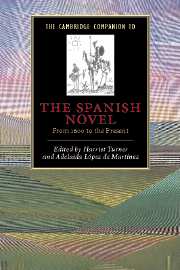Book contents
- Frontmatter
- 1 On the novel: mirror and text
- Part 1 Since Cervantes
- Part 2 The nineteenth century
- 4 The regional novel: evolution and consolation
- 5 The folletín: Spain looks to Europe
- 6 The realist novel
- 7 History and fiction
- 8 Gender and beyond: nineteenth-century Spanish women writers
- 9 Decadence and innovation in fin de siglo Spain
- Part 3 The twentieth century
- Bibliography
- Index
- Series List
5 - The folletín: Spain looks to Europe
from Part 2 - The nineteenth century
Published online by Cambridge University Press: 28 May 2006
- Frontmatter
- 1 On the novel: mirror and text
- Part 1 Since Cervantes
- Part 2 The nineteenth century
- 4 The regional novel: evolution and consolation
- 5 The folletín: Spain looks to Europe
- 6 The realist novel
- 7 History and fiction
- 8 Gender and beyond: nineteenth-century Spanish women writers
- 9 Decadence and innovation in fin de siglo Spain
- Part 3 The twentieth century
- Bibliography
- Index
- Series List
Summary
A critical approach to the nineteenth-century folletín must begin with an examination of this widely used term and with a revision of some of the prevalent ideas that frame our understanding of the literary and cultural nature of this novelistic production. The term folletín is not without problems. Based upon well-established critical notions, it has become a kind of critical steamroller that, while stressing some generally defined common traits, effectively cancels out all aesthetic differentiation among the texts included in this category. As we will see, some of these deep-rooted critical notions have to do with the poetics of the novel; others, with the Romantic understanding of literature as the highest expression of a nation's unique identity. Finally, the problematic nature of the term folletín is directly related to the highly influential distinction between High and Low forms of culture.
Folletín refers first of all to the form of publication of a novel. It describesthe market-induced fragmentation a novel underwent when published in thefolletín section of a newspaper. This section used to occupy the bottom partof one or more pages, or the last one, of a newspaper or journal, and was generallyused to publish a miscellany of social news and recreational items. Thepractice was first introduced in France in 1836 by the editors of the newspapersLa Presse and Le Siècle as a means to increase sales and, due to its greatsuccess, it was immediately adopted by most major newspapers and journalsall around Europe and America: in Spain it was already a well-establishedpractice in the 1840s.
- Type
- Chapter
- Information
- The Cambridge Companion to the Spanish NovelFrom 1600 to the Present, pp. 65 - 80Publisher: Cambridge University PressPrint publication year: 2003
- 2
- Cited by



